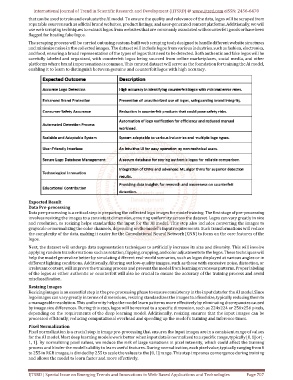Page 717 - Emerging Trends and Innovations in Web-Based Applications and Technologies
P. 717
International Journal of Trend in Scientific Research and Development (IJTSRD) @ www.ijtsrd.com eISSN: 2456-6470
that can be used to train and evaluate the AI model. To ensure the quality and relevance of the data, logos will be scraped from
reputable sources such as official brand websites, product listings, and user-generated content platforms. Additionally, we will
use web scraping techniques to extract logos from websites that are commonly associated with counterfeit goods or have been
flagged for hosting fake logos.
The scraping process will be carried out using custom-built web scraping tools designed to handle different website structures
and minimize noise in the collected images. The dataset will include logos from various industries, such as fashion, electronics,
and food, ensuring a broad representation of the types of logos that need to be detected. Both authentic and fake logos will be
carefully labeled and organized, with counterfeit logos being sourced from online marketplaces, social media, and other
platforms where brand impersonation is common. This curated dataset will serve as the foundation for training the AI model,
enabling it to learn to distinguish between genuine and counterfeit logos with high accuracy.
Expected Result
Data Pre-processing
Data pre-processing is a critical step in preparing the collected logo images for model training. The first stage of pre-processing
involves resizing the images to a consistent dimension, ensuring uniformity across the dataset. Logos can vary greatly in size
and resolution, so resizing helps standardize the input for the AI model. This step also includes converting the images to
grayscale or normalizing the color channels, depending on the model’s input requirements. Such transformations will reduce
the complexity of the data, making it easier for the Convolutional Neural Network (CNN) to focus on the core features of the
logos.
Next, the dataset will undergo data augmentation techniques to artificially increase its size and diversity. This will involve
applying random transformations such as rotation, flipping, cropping, and color adjustments to the logos. These techniques will
help the model generalize better by simulating different real-world scenarios, such as logos displayed at various angles or in
different lighting conditions. Additionally, filtering out low-quality images, such as those with excessive noise, distortion, or
irrelevant content, will improve the training process and prevent the model from learning erroneous patterns. Proper labeling
of the logos as either authentic or counterfeit will also be crucial to ensure the accuracy of the training process and avoid
misclassification.
Resizing Images
Resizing images is an essential step in the pre-processing phase to ensure consistency in the input data for the AI model. Since
logo images can vary greatly in terms of dimensions, resizing standardizes the images to a fixed size, typically reducing them to
a manageable resolution. This uniformity helps the model learn patterns more effectively by eliminating discrepancies caused
by image size differences. During this step, logos will be resized to a specific dimension, such as 224x224 or 256x256 pixels,
depending on the requirements of the deep learning model. Additionally, resizing ensures that the input images can be
processed efficiently, reducing computational overhead and speeding up the model's training and inference times.
Pixel Normalization
Pixel normalization is a crucial step in image pre-processing that ensures the input images are in a consistent range of values
for the AI model. Most deep learning models work better when input data is normalized to a specific range, typically [0, 1] or [-
1, 1]. By normalizing pixel values, we reduce the risk of large variations in pixel intensity, which could affect the training
process and hinder the model’s ability to learn useful features. During normalization, each pixel value, typically ranging from 0
to 255 in RGB images, is divided by 255 to scale the values to the [0, 1] range. This step improves convergence during training
and allows the model to learn faster and more effectively.
IJTSRD | Special Issue on Emerging Trends and Innovations in Web-Based Applications and Technologies Page 707

